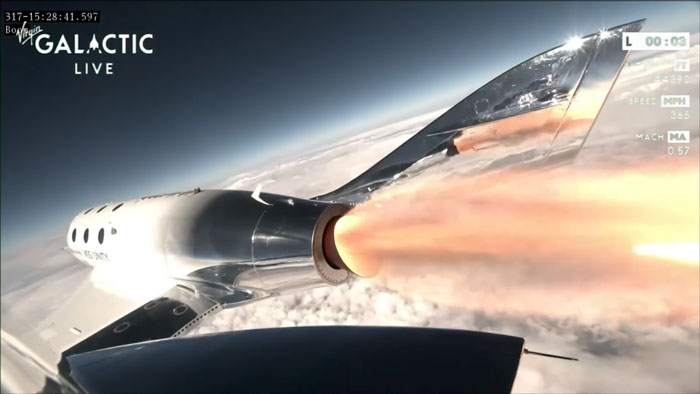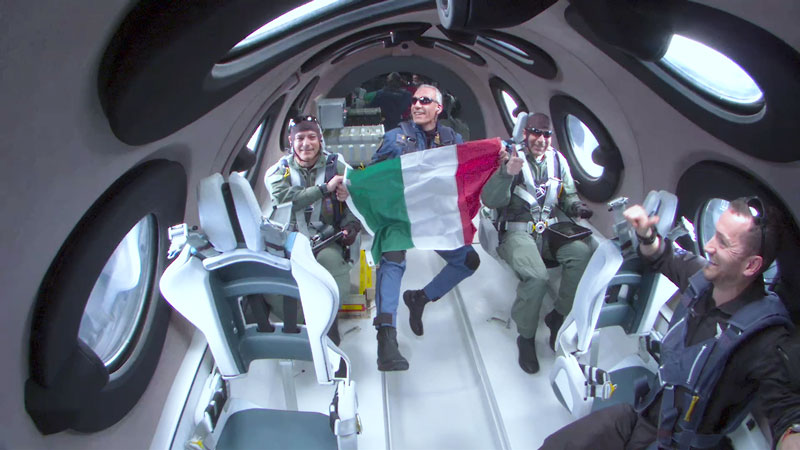Space News & Blog Articles
Virgin Galactic launches it’s first commercial flight to space
 VSS Unity ignites its engine after being released from its carrier aircraft. Image: Virgin Galactic.
VSS Unity ignites its engine after being released from its carrier aircraft. Image: Virgin Galactic.
Richard Branson’s Virgin Galactic launched its first commercial space flight Thursday, sending three Italian researchers, two company pilots and an astronaut trainer on a high-speed thrill ride to the edge of space aboard a winged rocketplane.
“Che volo fantastico [what a fantastic flight]!” Branson tweeted. “An historic moment – @virgingalactic’s first commercial spaceflight completed. Ben fatto [well done].”
Che volo fantastico! An historic moment – @virgingalactic’s first commercial spaceflight completed. Ben fatto #Galactic01 https://t.co/eWHfISJjz0 pic.twitter.com/7NU5JdoyDT
— Richard Branson (@richardbranson) June 29, 2023
Cheered on by Virgin employees, family members and friends gathered at Spaceport America in New Mexico, the twin-fuselage VMS Eve carrier jet took off at 10:30 a.m. EDT, carrying the company’s VSS Unity spaceplane and its six passengers up to an altitude of about 44,500 feet.
After final checks, clamps opened and Unity dropped like a bomb from Eve’s mid-wing attachment mechanism at 11:28 a.m.
Seconds later, the spacecraft’s hybrid rocket motor ignited with a rush of flame, instantly propelling Unity up and out of the lower atmosphere on a near-vertical trajectory. Cameras mounted on the hull of the ship showed the Earth dropping away and the sky changing from blue to deep black as the ship raced toward space.
One minute later, now traveling 2.8 times the speed of sound at an altitude of 136,000 feet, the rocket motor shut down, leaving the six crew members weightless as Unity coasted up to an altitude of 52.9 miles, nearly three miles higher than the somewhat arbitrary 50-mile-high “boundary” between space and the discernible atmosphere.
Along the way, veteran pilot Mike Masucci and rookie co-pilot Nicola Pecile “feathered” the ship’s wings, folding the swept-back wing-tip fins up about 60 degrees in a unique procedure invented by legendary aircraft designer Burt Rutan to minimize heating and speeds during re-entry.
 Italian Air Force Col. Walter Villadei unfurls an Italian flag as he and the crew enjoy a few minutes of weightlessness. Image: Virgin Galactic.
Italian Air Force Col. Walter Villadei unfurls an Italian flag as he and the crew enjoy a few minutes of weightlessness. Image: Virgin Galactic.
In the meantime, Italian Air Force Col. Walter Villadei, Lt. Col. Angelo Landolfi and Pantaleone Carlucci, representing Italy’s National Research Council, began carrying out or monitoring 13 experiments designed to collect data about the effects of weightlessness on themselves and a variety of technological processes.
Amid switch throws and experiment activations, Villadei took a moment to unfurl an Italian flag as he floated above his crewmates.
The researchers were assisted by Colin Bennett, Virgin Galactic’s chief astronaut trainer. It was the company’s sixth piloted sub-orbital space flight and the first to carry paying customers, a milestone that has taken the company more than a decade longer than expected to achieve.
As with all such sub-orbital flights, the crew only had about three minutes of weightlessness as the ship arced over the top of its trajectory and began falling back to Earth, weightlessness giving way to increasing “G” loads as the vehicle rapidly slowed during re-entry.
Finally, back in the dense lower atmosphere, Unity’s two wing fins rotated back down to their normal positions and the pilots manually flew the spaceplane through a spiraling glide to landing on Spaceport America’s 12,000-foot-long runway. Total time between Unity’s air launch and landing: just under 14 minutes.
Virgin has now launched 25 people to the edge of space, several of them more than once, including Masucci, making his fourth flight, and Bennett, making his second. Arch rival Blue Origin, owned by Amazon-founder Jeff Bezos, has launched 32 people on six sub-orbital spaceflights using its more traditional New Shepard booster and capsule.
The competition between the two companies in the space tourism marketplace has been fierce.
Virgin’s first space flight came in 2018 when two company pilots flew Unity to an altitude of 51 miles. That initial launch to space came four years after a catastrophic test flight that destroyed Virgin’s original spaceplane, killed the co-pilot and seriously injured the pilot when the feather mechanism was unlocked earlier than planned.
After addressing that issue, Virgin launched four successful test flights in a row before standing down for two years to upgrade the Eve carrier jet and carry out more modifications. A fifth successful test flight on May 25 cleared the way for Thursday’s launch.
Blue Origin, meanwhile, began commercial operations in 2021. But the company’s most recent launch in September 2022, an uncrewed research flight, suffered a booster malfunction. While the capsule’s abort system operated as planned and the ship landed successfully, launches currently are on hold.
The six-member crew of Blue Origin’s fifth flight in June 2022 included Hamish Harding, a billionaire pilot and explorer who was killed along with four others when the submersible Titan imploded June 18 during a commercial dive to view the wreckage of the Titanic. The mishap has raised fresh questions about the risks of private ventures into inherently dangerous environments.
Commercial spaceflight in the United States is monitored by the Federal Aviation Administration, which is responsible for licensing and ensuring minimal risk to the public. But legislation forbids the FAA from regulating crew safety procedures during a so-called “learning period” as as the commercial space market matures. Instead, passengers must provide “informed consent” that they understand the risks.
That learning period expires October 1, and the FAA is considering steps it might take if Congress does not extend the deadline.
“This includes the establishment of an Aerospace Rulemaking Committee to provide recommendations on the scope and costs of future regulations,” the FAA said in a statement. “The FAA also is updating its recommended practices for human spaceflight occupant safety and is working with international organizations to develop voluntary consensus standards.”
When you subscribe to the SpaceZE News Feed, we will send you an e-mail when there are new updates on the site so you wouldn't miss them.

